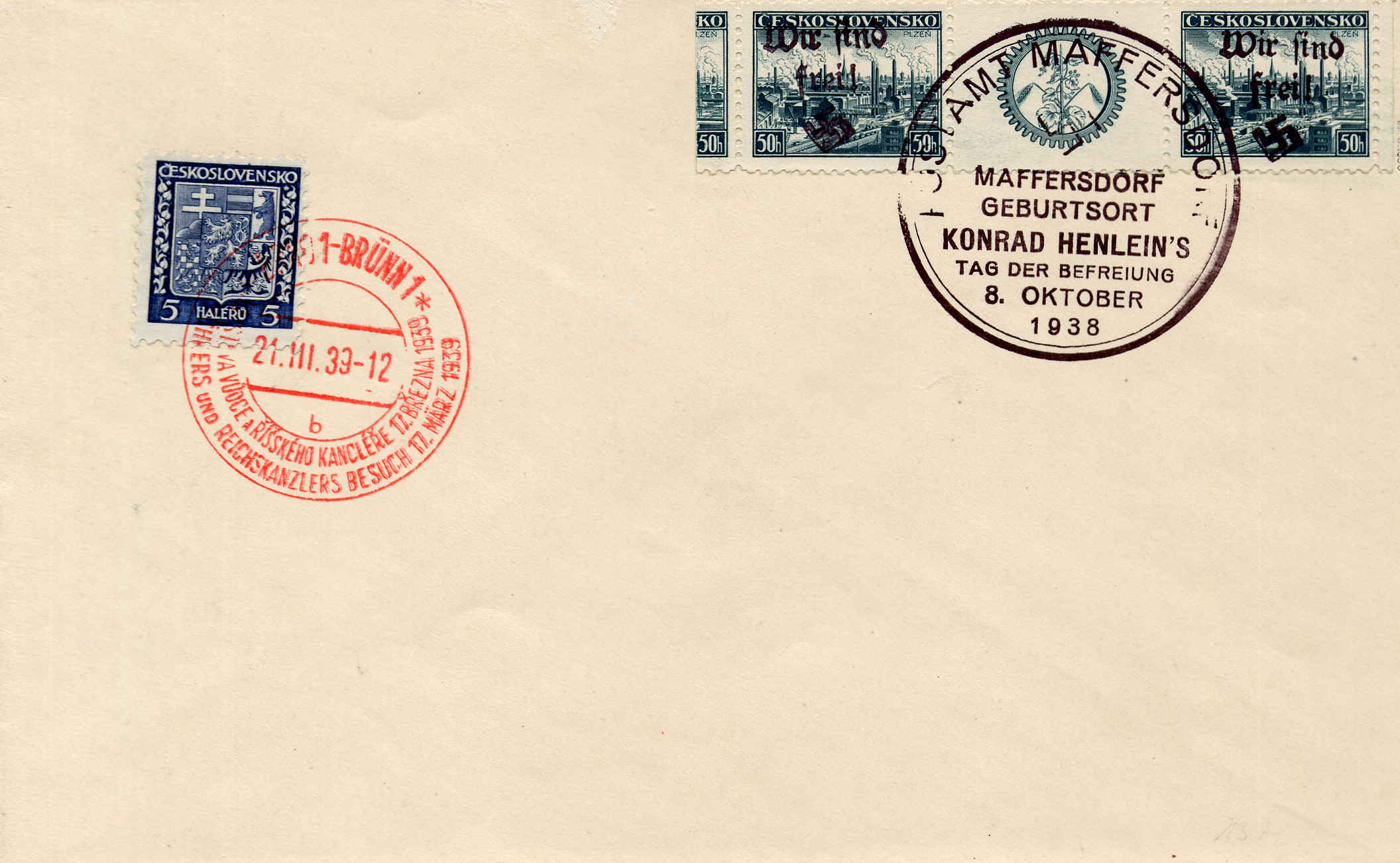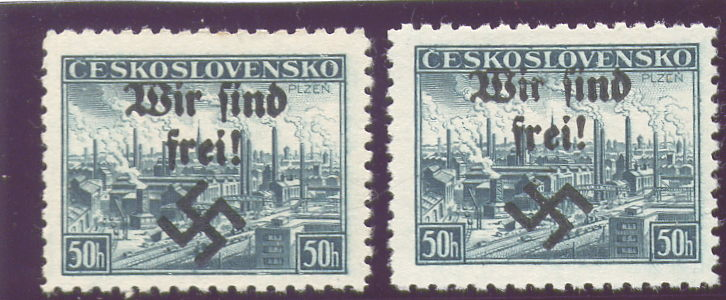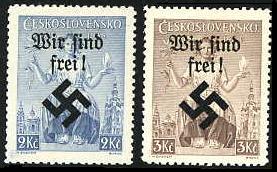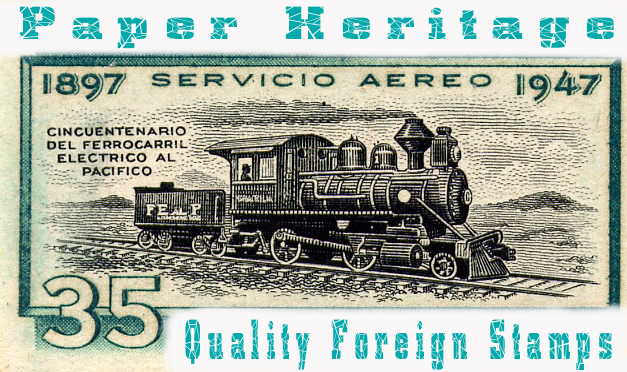Sudetenland Philately 1938
Exact dates of issue for Sudetenland stamps are, in general, not known. Curiously, the one issue ( from Asch ) for which a date is given, September 21st, pre-dates the occupation by 10 days and the Munich Agreement by 8 days. Generally, though, postmarked stamps and covers carry dates in early October 1938. Almost all covers ( and used stamps ) bearing Sudetenland overprints are philatelic, their period of validity ending as early as October 19th 1938.
Overprints were applied to Czech stamps in a number of towns / districts but only those from Asch, Karlsbad, Konstantinsbad, Niklasdorf, Reichenberg-Maffersdorf, Rumburg and Sudetendeutsches Niederland are recognized as authorized issues. Except for the first and last in the above list, all these places overprinted the same Czech stamp of railway interest, the 1938 50 heller Steam Train & Armaments Works in Pilsen ( Czechoslovakia Mi. 400 ). This stamp exists with a pictorial, horizontal interpanneau label ( producing ' gutter pairs ' ). Some of the Sudetenland stamps also exist in this format, as shown below.
The overprint ' Wir sind frei ! ', applied in several districts, is German for ' We are Free ! '. Forgeries exists and collectors should try to acquire examples which have been expertised. Dr. Dub and Dr. Hörr, amongst others, are recognized for their expertise on these issues. The railway values are all scarce, although the Rumburg is certainly more plentiful than the others.
All illustrations are ABOVE the stamp descriptions in this article.

Karlsbad : Optd. ' Karlsbad / 1.X.1938 / ( swastika ) ' in
Red
[ . . ] 50h blue-green ( Mi. 62 )
[ . . ] - ditto - interpanneau
pair ( label also overprinted ) ( Mi. 62WZ )
Konstantinsbad : Optd. ' Sudetenland ' in Black
[ . . ] 50h
blue-green ( Mi. 34 )
[ . . ] - ditto - interpanneau pair ( I do not know if
the label is overprinted ) ( Mi. 34WZ )


Niklasdorf : Optd. with new value in Black
[ . . ] 1.20 Kc /
50 h blue-green( Mi. 47 )
[ . . ] 2 Kc / 50 h blue-green ( Mi. 73 )
[ . .
] 4.50 Kc / 50 h blue-green ( Mi. 120 )
[ . . ] - ditto - interpanneau pair (
label not overprinted ) ( Mi. 120WZ )

Reichenberg-Maffersdorf : Optd. ' Wir sind / frei ! / ( swastika )
' in Black.
[ . . ] 50 h blue-green ( Mi. 137 )
[ . . ] - ditto -
interpanneau pair ( label not overprinted, expertised Osper ) ( Mi. 137WZ )
[
. . ] - ditto - interpanneau pair ( label with overprint, expertised Hübner ) (
Mi. 137WZ )
Note: I have also seen an interpanneau pair ( label not
overprinted ) overprinted in a deep bluish-black, expertised by Osper.
Intriguing. They may all be authentic, but I do not have enough information to
provide proper analysis.

Left Stamp: Rumburg ( normal ). . . Right stamp : Rumburg - missing bar to swastika . . . Colour not true in this scan
Rumburg : Optd. ' Wir sind / frei ! / ( swastika ) in Black
(smaller opt than above )
[ . . ] 50 h blue-green ( Mi. 51 )
[ . . ]
- ditto - variety - Swastika with missing bar ( Position 71 in the sheet, rarely
seen )
.
German Occupation of Bohemia & Moravia, March 1939.
German troops invaded Bohemia & Moravia in March 1939. Czech stamps continued to be used until November 1939, supplemented by regular issues for the ' Protectorate ', which became available from July 15th. From December 1939 onwards, only Bohemia & Moravia stamps could be used, a few of which are of railway interest. Some of these exist with a variety of blank fields ( Leerfeld ) in the sheets. However, I am not covering these somewhat complex issues in this article.
There is one stamp, however, which is perhaps best listed here, as its
overprint is very similar in design to the overprint on some of the Sudetenland
stamps above. As early as March 14th 1939, German troops occupied the town of
Mährisch-Ostrau and several Czech stamps were overprinted Wir sind / frei ! / (
swastika ). These stamps were only valid in Mährisch-Ostrau and are, therefore,
listed by Michel as Local Issues .
Once again, the only stamp of
railway interest, so overprinted, was the 1938 50 heller Steam Train &
Armaments Works in Pilsen ( Czechoslovakia Mi. 400 ). I am unable to provide a
scan of the actual stamp but the overprint in use is illustrated below. You will
notice that the swastika is, proportionately, much larger than on the
Sudetenland issues.

[ . . ] 50h blue-green ( Pilsen ) overprinted as above ( Local Issue for
Mährisch-Ostrau ) ( Mi. A.29 )
[ . . ] - ditto - Gutter pair
Note
1: Although the gutter pair is not listed in my edition of Michel, I believe it
has been listed in the current edition ( requires confirmation ).
Note 2 :
Michel reports that there are three variations of the exclamation mark in the
overprint,
I : Downstroke and Stop joined
II : Stop separated, downstroke
rounded at top
III : Stop separated, downstroke more diamond-shaped at
top
.
Links to other pages of this website:
Click here to return to Index Page of Railway Articles
Click here to go to Index Page of Railway Stamps for Sale
Click here to go to Railway Stamps for Sale - Countries A & B
Click here to return to Paper Heritage Home Page
 .
.